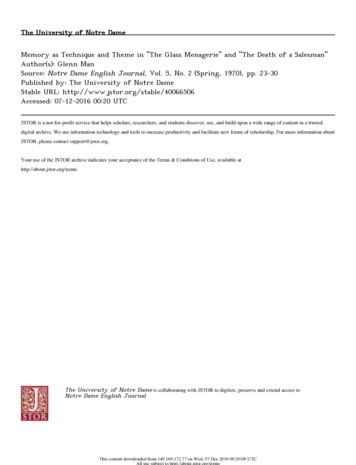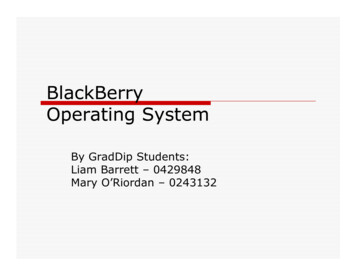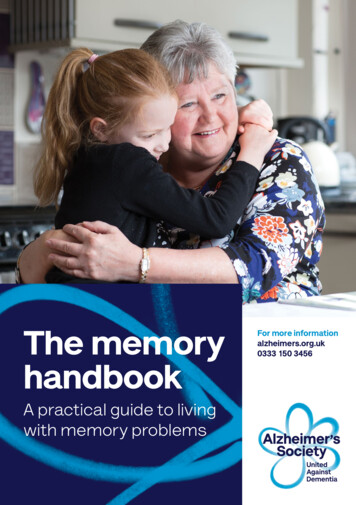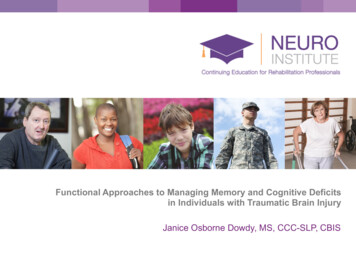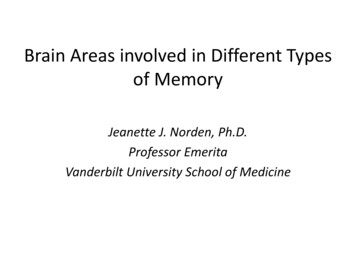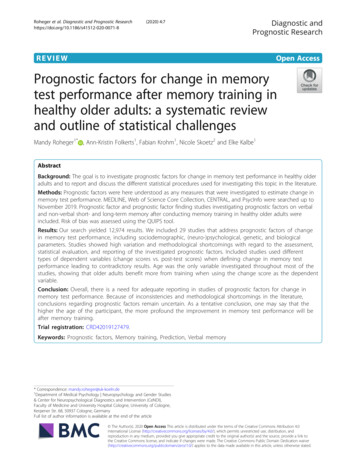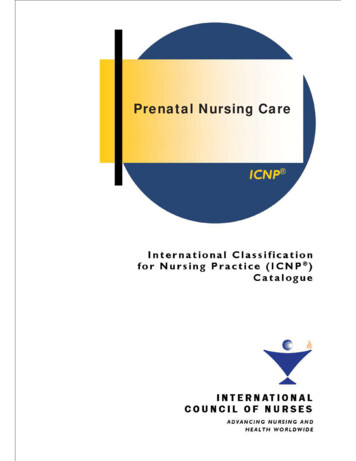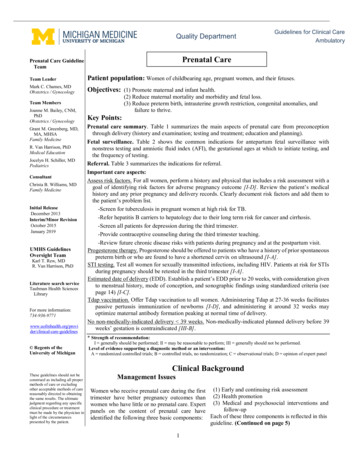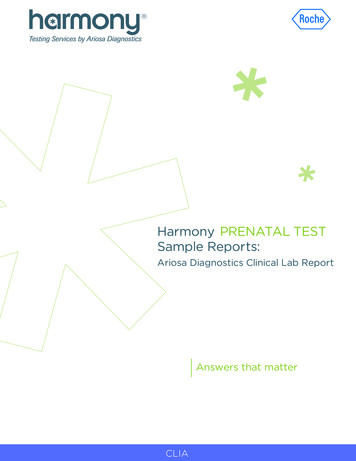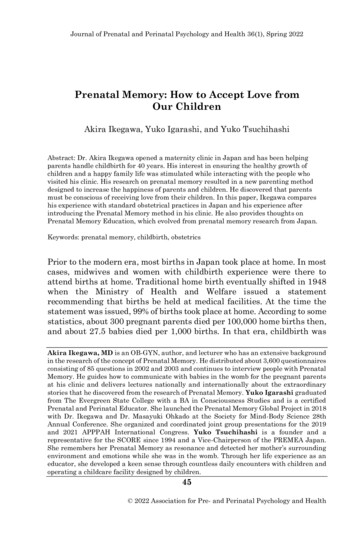
Transcription
Journal of Prenatal and Perinatal Psychology and Health 36(1), Spring 2022Prenatal Memory: How to Accept Love fromOur ChildrenAkira Ikegawa, Yuko Igarashi, and Yuko TsuchihashiAbstract: Dr. Akira Ikegawa opened a maternity clinic in Japan and has been helpingparents handle childbirth for 40 years. His interest in ensuring the healthy growth ofchildren and a happy family life was stimulated while interacting with the people whovisited his clinic. His research on prenatal memory resulted in a new parenting methoddesigned to increase the happiness of parents and children. He discovered that parentsmust be conscious of receiving love from their children. In this paper, Ikegawa compareshis experience with standard obstetrical practices in Japan and his experience afterintroducing the Prenatal Memory method in his clinic. He also provides thoughts onPrenatal Memory Education, which evolved from prenatal memory research from Japan.Keywords: prenatal memory, childbirth, obstetricsPrior to the modern era, most births in Japan took place at home. In mostcases, midwives and women with childbirth experience were there toattend births at home. Traditional home birth eventually shifted in 1948when the Ministry of Health and Welfare issued a statementrecommending that births be held at medical facilities. At the time thestatement was issued, 99% of births took place at home. According to somestatistics, about 300 pregnant parents died per 100,000 home births then,and about 27.5 babies died per 1,000 births. In that era, childbirth wasAkira Ikegawa, MD is an OB-GYN, author, and lecturer who has an extensive backgroundin the research of the concept of Prenatal Memory. He distributed about 3,600 questionnairesconsisting of 85 questions in 2002 and 2003 and continues to interview people with PrenatalMemory. He guides how to communicate with babies in the womb for the pregnant parentsat his clinic and delivers lectures nationally and internationally about the extraordinarystories that he discovered from the research of Prenatal Memory. Yuko Igarashi graduatedfrom The Evergreen State College with a BA in Consciousness Studies and is a certifiedPrenatal and Perinatal Educator. She launched the Prenatal Memory Global Project in 2018with Dr. Ikegawa and Dr. Masayuki Ohkado at the Society for Mind-Body Science 28thAnnual Conference. She organized and coordinated joint group presentations for the 2019and 2021 APPPAH International Congress. Yuko Tsuchihashi is a founder and arepresentative for the SCORE since 1994 and a Vice-Chairperson of the PREMEA Japan.She remembers her Prenatal Memory as resonance and detected her mother’s surroundingenvironment and emotions while she was in the womb. Through her life experience as aneducator, she developed a keen sense through countless daily encounters with children andoperating a childcare facility designed by children.45 2022 Association for Pre- and Perinatal Psychology and Health
46Journal of Prenatal and Perinatal Psychology and Healthconsidered a life-threatening experience for both the pregnant parent andchild (Ministry of Health, Labour, and Welfare, 2011).The Ministry of Health and Welfare switched from supporting homebirths to institutional births, hoping to ensure safer childbirthexperiences. The Ministry issued a statement to encourage the public togive birth in institutions. As a result, people began to give birth inhospitals, clinics, and midwifery centers, instead of at home. By the year1975, almost a quarter of a century after the government’s new policy hadbeen instituted, 99% of births took place in institutions. As a result ofthese changes, maternal deaths improved to 27.3 per 100,000 births andneonatal deaths to 6.8 per 1,000 births by 1975. Developmentalimprovements in obstetric and neonatal care also contributed to thecontinued improvement in safety during childbirth. In present-day Japan,maternal deaths have improved significantly to 4.8 and neonatal deathsto 0.9, making it extremely rare for an individual to lose their life duringchildbirth.The quality of obstetric care has tended toward improvement year byyear. At the same time, the number of expectant and nursing parentsreport anxiety during pregnancy, as well as difficulty in raising children(Ministry of Education, Culture, Sports, Science and Technology, n.d.) anddepression after childbirth (Matsuoka, 2009) which has been increasingwith each passing year (Ohinata, n.d.).While modern obstetric care is quite sufficient in terms of saving thelives of birth parents and children, there is little consideration given tothe life experience of individuals as a result of their childbirth experiences.There are many cases where the experience of childbirth, which is a greatlearning experience for human beings, does not result in their happinessand health in life after childbirth. This may be due to the lack of aphilosophical perspective on the meaning of birth among obstetricalpractitioners. To counteract this lack of a philosophical perspective,Ikegawa’s approach is to inform parents about the concept of prenatalmemory before and during pregnancy. He predicted that parents’awareness of prenatal memory would lead to improved parent-child andfamily relationships both before and after birth.Research on Prenatal MemoryIkegawa first became aware of the concept of prenatal memory around1998. At that time, he came across a best-selling book by Fumihiko Iida(trans. Yoshikawa, 1996), Creating the Value of Life, which was based onknowledge and concepts obtained through regression hypnosis. The bookalso described how to have a sense that life is worth living. Iida wrote thatchildren have consciousness and memories from the time they are in thewomb. Ikegawa used the knowledge he gained from these books and
Ikegawa et al.47conducted interviews with the pregnant parents who were raising theirchildren, asking them about their prenatal memories. He presented hisfindings to medical groups as well as submitted an article to a magazine.He then expanded the scope of research and conducted a questionnairesurvey of all the parents enrolled in every public nursery school in aparticular area in 2002—2003. The results of this research led to asummary of prenatal memory that has become the basis of subsequentresearch (Ikegawa, 2005).Trends and History of Childcare in JapanAmong children who could recall experiences immediately after birth,there were several cases in which they described these experiencesas “unpleasant memories” of being separated from their parents andtaken immediately to the neonatal ward. These children stated that rightafter birth newborns want and need to be close to their birth parents. Asmentioned earlier, the Ministry of Health and Welfare announced thenational policy of institutional birth in the year 1948 in Japan, whichresulted in a massive surge in the number of institutions handling births.Because of this shift, newborns were isolated in the neonatal ward frombirth until discharge, approximately one week. By 1975, this practice wasestablished throughout Japan.Most families in Japan at that time practiced bathing and sleepingtogether. This meant that, although newborns were isolated from thebirth parent for a week immediately after birth, they had an intimateconnection with the family after the discharge from the hospital. However,for 20 years starting in 1964, the Ministry of Health and Welfare printedand distributed 1.6 million pamphlets per year, advising parents not tosleep with their children, or carry them in their arms or on their backsafter birth (Yoshitani, 2017). Because this recommendation was continuedby the Ministry of Health and Welfare for a long time, the tendency toseparate parents and children has become more common, not only duringthe hospitalization period but also after leaving the hospital. During thesedecades, many children were born and raised without being carried orslept with, and they were separated from their parents. This led manypeople to believe that separation and distance were the right way to raisechildren. It created a world where carrying a baby was frowned upon anddiscouraged, in the belief this would spoil the child (PREMEA, 2017).After 20 years of exposure to the booklet recommending the separationof parents and children, the policy was suddenly changed to encouragepeople to carry their babies. But the message that had been ingrained inthe society for 20 years did not simply disappear. The people who wereraising their children during this period felt that they were providing thebest care for their children. However, many of their babies had little to nodirect contact through carrying with their parents and/or caregivers. This
48Journal of Prenatal and Perinatal Psychology and Healthled to a large number of adults who felt that they did not receive enoughlove and affection from their parents (The Hitachi Global Foundation &Okada, n.d.). If we consider the generation of people who did notexperience love from their parents in the process of growing up as the firstgeneration, we are already in the era of the second and third generationsof children being born from these adults. These adults, who have grownup without feeling loved, tend to have difficulty in expressing their love tothe following generation of children (Kubota, 2010). Thus, a negativechain of cause-and-effect has begun in which the unloved generation givesbirth to another unloved generation.The Relationship between Parent and Child Revealed fromPrenatal MemoryResearcher Yuko Tsuchihashi, who maintains her own clear prenatalmemory, reported that the sensations she felt in the womb werecompletely synchronized with her mother. She could not distinguishwhether the information she received was from her mother or her owndirect experience.When she first entered the nursery school run by her parents at theage of four, Tsuchihashi was still a very young child herself, but she closelyobserved how adults interacted with children. She has been researchingalternative methods for childcare and varied parenting styles for the past40 years, based on observations of the children in her facility. She hasbeen applying knowledge gained from her experiences to the facility sheis managing and is receiving great feedback from parents. The newmethods of parenting that Tsuchihashi has developed with children arenot based on the traditional view of children from the perspective ofadults, but rather on the viewpoint of children in which they express thewish to be equally treated. Children who grow up with this new approachappear more confident and self-sufficient. They enter elementary schoolwith a clearer understanding of what they want to achieve in life.Tsuchihashi posits that the most important thing to recognize inraising children is that the child and the birth parent are two distinctentities, beginning in the prenatal period. She stated that, normally, thedyad’s senses are in sync, so much so that the child has difficultydistinguishing between their own senses and those of the pregnantparent. Tsuchihashi experienced the mixing between her own feelings andher mother’s—she felt as if they were inseparable. Moreover, she arguesthat it is very important to identify this sense of unity from the prenatalperiod in order to develop a sense of self-identity. The unborn baby canbegin to develop their own autonomy when their caregivers regularly askthem to make choices, such as, “Which do you prefer?” It allows the unbornbaby to have autonomy.
Ikegawa et al.49If the unborn baby begins to learn that they are separate from theirparents, it will speed up the time it takes for the child to recognize thatthey are independent after birth. This may be crucial for futuregenerations. According to Tsuchihashi’s prenatal memories, she chose toassimilate her mother’s consciousness when she was a fetus; after thattime, she used to have difficulty living her life because she felt she mergedwith her mother’s consciousness, losing her own sense of existence. Nowthat she is an adult, Tsuchihashi looks back on her past experiences andsays:The unborn child is sharing information about everything in theirdaily lives including their pregnant parent’s emotions and behavioralchoices. It is very difficult for the fetus to distinguish whether theseemotions and behavioral patterns are their own or those of thepregnant parent. the prenate is able to learn about the pregnantparent’s patterns and learn the differences between themselves andthe pregnant parent from the fetal stage and to experience thesedifferences together throughout the pregnancy. Children who haveexperienced this pregnant parent-fetus difference and learn from itare better able to understand and act on their own in many situationsin life and are able to be respectful of their own wishes.Based on her experience of learning through non-verbalcommunication with children on a daily basis, Tsuchihashi stronglybelieves that in order to prevent children from growing up with difficultiesin life, we, as adults, need to respect the “children's point of view” and seethings from their perspective.From the prenatal period to after birth, children are sending massiveamounts of love to their parents. However, according to a May 2010Cabinet Office survey on the causes of delinquency report, parents are notfeeling this love from their children (Cabinet Office, 2010). While the lovethat parents send to their children reaches them, sadly children needmore than the love they receive (PREMEA, 2017). Only when parents canreceive the love their children have for them, do the children then feel thatthey are loved by the parents. By creating a cycle of love between parentsand children, the child can establish a sense of self-efficacy that they haveserved their parents, as well as a sense of self-affirmation that validatestheir existence.Children can attest that by continuing this cycle of love even afterbirth, children have achieved their first mission, “To make their parentshappy” (PREMEA, 2017). They can then immediately begin their primarymission, which is their personal mission in life. You can imagine giving agift to someone as an example. Let’s imagine that a gift from a parent isreceived by their child, but the parent would not accept a gift from thechild. The parents believe they are doing a good job for their child, but the
50Journal of Prenatal and Perinatal Psychology and Healthchild whose gifts cannot be received by the parents may feel helpless andisolated. The authors believe that this phenomenon is the beginning of asense of deprivation and interferes with the child’s sense of self-efficacyand self-affirmation. Many children are feeling sad that their gifts are notreceived by their parents.Yuko Tsuchihashi remembers the sensation of being a particle veryclearly from her early life, and Ikegawa has posited that her particle maybe an undiscovered particle that is smaller than a subatomic particle.Tsuchihashi explains her feeling that the particle itself is consciousness,as well as “love.”In the book, Tracking Consciousness Before Birth and Beyond,Jaroslav Vlcek (2017) explains and analyzes the time sequence from thebeginning of consciousness to birth. He shows the relationship betweenthe scientific and empirical knowledge of life and the various events thatoccurred during the period from conception to birth, including therelationships. The various events that took place during this prenatalperiod and how life is shaped from the existence of the primordial embryoto birth are explained in detail in three parts.The particles experienced by Tsuchihashi and the beginning of Vlcek’sconsciousness may be different ways to explain the same things. Based onthese two testimonies, we might consider the possibility that there is aphysical mechanism of transmitting information to others through thesesmall particles.The Consciousness and Material Aspects of Love betweenParents and ChildrenBased upon the above discussion, Ikegawa offers the hypothesis thatlove is a system that is transmittable by a physical substance. The currentview is that the transmission of information between cells in the body canbe explained by vesicles, such as exosomes that circulate in the body(Verny, 2021). These vesicles are known to transmit information to distantorgans via mRNA, microRNA, and proteins. The exosome is estimated tobe 50—150nm in size, which is similar to the size of an odor molecule.Odor molecules are estimated to be 3—30nm in size. If odor molecules arereleased from the body through sweat glands, etc., and people nearby canrecognize that odor, then we can also propose that a vesicle that is secretedwhich transmits information to outside of the body of approximately thesame size (Verny, 2021).Let’s imagine that there is a physical phenomenon that envelops aperson like a mist, containing vesicles that are filled with information oflove and going out of the body. Assuming that the inside of the vesicle ispacked with these small particles and that these particles contain
Ikegawa et al.51information of love, the mechanism of love transmission can be explainedas a physical phenomenon.Here is a specific example of this phenomenon. What if we assumethat nursing is more than just giving the child the nutrients and immunesubstances provided by breast milk? Would it be possible to think ofnursing as a system that physically transmits information about theparent’s love to the baby? We think that nursing is one way to pass on theinformation of parental love, via vesicles released in the breast milk andthrough the parent’s skin and transmitted into the baby’s body.Tsuchihashi, however, proposes that the transmission of love from theparent to the child is inadequate. She believes that children release morelove from their whole body than their parents express. For this reason,Ikegawa tried to describe the transmission of love from children to theirparents as a physical phenomenon by comparing the released love with“vesicles.” There are physical signs that a parent has received love fromtheir child. Tsuchihashi says these signs include the parent’s big smile,gentle gaze at the child, flushed cheeks, elevated body temperature, andother physical signals that are sent to the child. The signs that childrensend to their parents would be a smile and a good mood. By exchangingthese bi-directional signals between parent and child, the childunderstands that they have received love from their parent. Ikegawaspeculated that when this bi-directional communication of love isconsciously implemented for the first time, the love that reaches thechild’s heart will be activated.The conventional wisdom is that there is no thought or memory fromembryo to infancy. However, the concept of prenatal memory suggeststhat children have memories and consciousness from the time they are inthe womb. The birth parents who have memories of being loved andnurtured could be able to exchange affection in both directions with theirchildren in an unconscious manner. However, those who do not recallreceiving affection from their parents during their infancy will have to bemore conscious about this two-way communication. This is the first steptowards stopping the intergenerational cycle of not being able to feel love.Pregnant parents in particular need to be aware that a tremendousamount of love from the unborn baby is pouring into the pregnant parent.The moment the pregnant parent learns about prenatal memory andrealizes that the baby is conscious in utero, they activate the massiveamount of love from the baby that is flowing into their body and manifestit as love.One of the basic elements that will bring peace of mind to thechild’s life is the activated love from the pregnant parent that istransmitted to the child. The child is aware that they are loved by theparent. This awareness is activated in both the conscious andsubconscious minds of children. The authors believe that this sequence of
52Journal of Prenatal and Perinatal Psychology and Healthevents is an essential and fundamental element at the beginning of life tofulfill our lives.There are several types of love described here. The first one is the lovefor personal growth, which requires a bi-directional transfer of love toactivate based on the concept of prenatal memory. To fulfill a life’smission, one must activate this first mission. Children release physicalsubstances from their bodies to transmit love and it is activated themoment the caregivers accept the love. Then, love is triggered in the childand a sense of self-empowerment is activated. Even if there is a conflictbetween parent and child during this period, there will be few problems ifthe first phase of love is activated.The second is the love of communication, which is nurtured throughrelationships with parents and family. This requires continuous mutualunderstanding and progressively develops a sense of self-sufficiency.During this period, the parents and the child are preparing for the thirdkind of love, love that is extended to all fellow humans. The third kind oflove is the love that gives us a sense of satisfaction that we arecontributing to society by demonstrating our abilities. When the scale ofthe contribution becomes wider, it will no longer be in the form of materialexchange of information, but in the form of radio waves or quantumwaves, which are of a different state. There are probably many other waysto transmit information that we are not currently recognizing.ConclusionIkegawa and colleagues have hypothesized the idea of a physicalsystem of transmitting love. The moment a pregnant parent learns aboutprenatal memory and realizes that the baby is conscious in utero, thesystem of love transmission will start operating. In other words, theauthors believe that the first process for parents in consciously raisingtheir children should be to activate the system that enables them to feellove from their children throughout the pregnancy and childbirth period.The authors pondered the possibility that the parental lovetransmission from parents to children was dysfunctional because thepregnant parents weren’t consciously accepting the love from theirchildren. The moment parents receive the love emitted by their children,a bi-directional cycle of love flows from the parents to the children andfrom the children to the parents. By maintaining the physicaltransmission system of this circulation of love, a well-balanced sense ofself-affirmation and self-efficacy will be established in the children.This awareness of the bi-directional flow of love will have a powerfuleffect on the parent-child relationship as the concept of prenatal memoryis introduced into the field of pregnancy, childbirth, and parenting. It isour hope that understanding the physical transmission system of love
Ikegawa et al.53will provide a solution to many of life’s traumas and challenges. Topromote this concept, we have established the Prenatal MemoryEducation Association and will continue to actively disseminate thisinformation through courses and other means, so that this concept willbe accepted not only in Japan but also around the world.ReferencesCabinet Office. (2010, May). Session 4: Outline of the Comprehensive ResearchStudy on the Causes of kou4/gaiyou/gaiyou.html?fbclid rC IYskynOYThe Hitachi Global Foundation & Okada, T. (n.d.). Attachment disorders indisrupted families, Mirai, 2. The Hitachi Global Foundation Web aper/pdf/okada treatise.pdfIida, F. (trans. Yoshikawa, 1996). Creating the value of life.https://trans4mind.com/download-pdfs/Creating the Value of Life.pdfIkegawa, A. (2005). Investigation by questionnaire regarding fetal/infantmemory in the womb and/or at birth. Journal of Prenatal & PerinatalPsychology & Health, 20(2), 121—133.Matsuoka, E. (2009, March 31). Cultural construction of maternity blues andpostpartum depression [in Japanese]. Senri Ethnological Reports, 85, 155—171. 10.15021/00001125Ministry of Education, Culture, Sports, Science and Technology. (n.d.). Currentsituation and background of children's development, 4, Retrieved February25, 2022, fromhttps://www.mext.go.jp/b mMinistry of Health, Labour, and Welfare kou/geppo/nengai11/toukei02.htmlOhinata, M. (n.d.). Modern child-rearing environment and local child-rearingsupport: Current status and eting/taikou/k 3/pdf/s41.pdf?fbclid IwAR07Z0tgrYU-iiAiFAMbNENivgNqBziDrzKTKQI9e3iRN lMgU1e1cxvzPREMEA, (Ed.).(2017). Basic Course Textbook, 6, 40, 56—76, Prenatal MemoryEducation Association.Verny, T. (2021). The inheritance of change. In Change: Birthing & Parenting atTime of Crisis, O. Gouni, JRG Turner, & TGN Turner-Groot (Eds.), 157–197.Cosmoanelixis.Vlcek, J. (2017). Tracking consciousness before birth and beyond. FriesenPress.Yoshitani, S. (2017). Gendaijin no denki [Modern human electricity], 1,Chichishuppansha.
Journal of Prenatal and Perinatal Psychology and Health 36(1), Spring 2022Effectiveness of a Pre-Conception Education Programin India at Improving Fertility RatesGajanan Kelkar, Avinash Dharmadhikari, and Amita DharmadhikariAbstract: The problem of infertility is rapidly growing in India. Increased stress is onemajor cause of this. Pulling from the study of epigenetics, the Manashakti Research Centredeveloped the Pre-Conception Education (PCE) program—its main objective is to increasefertility among participants. The PCE has been conducted bimonthly since January 2010.This article studies the effectiveness and outcomes of practicing PCE in correlation withincreasing fertility for couples by using feedback from surveys of couples who haveparticipated in PCE from January 2016 to December 2018. Analysis revealed that fromwithin the heteronormative, cis-gender couples, when the potential mother is under stress,practicing PCE increased fertility rates for the couple.Keywords: DASS-42 test, Pre-Conception Education (Suprajanan), Pearson’s chi-squaretestThe Manashakti Research Centre (MRC) Lonavla, near Mumbai, India,has been engaged in the Prenatal Project since 1960. The goal of theproject is to welcome the baby with good thoughts, impart positive valuesto the fetus, improve the emotional health of the parents, increase theGajanan Kelkar is the Trustee and Research Director of the Manashakti Research Centre,a Charitable Trust in Lonavla, India and has directed the Prenatal Project for the last 31years. He initiated and developed the Pre-Conception Education program and regularlyconducts the workshops. He holds a Master’s degree in engineering (MTech.) from the IndianInstitute of Technology, Mumbai, and has designed many instruments used in Preconception and Prenatal projects. He presented at APPPAH’s Congresses in 2001, 2009 and2013. Dr. Avinash Dharmadhikari was a Professor of Statistics at Pune University (India)until December 2004. His research interests include exploratory data analysis, life testingand reliability, and planning of experiments. He is associated with the Manashakti ResearchCentre, Lonavla, and guides the analytical work. Dr. Amita Dharmadhikari is a M.Sc.,Ph.D. in Statistics. She is a retired professor of statistics from India and her researchinterests mainly are in Applied Statistics. Earlier she had worked in Disputed Authorship.For the last 20 years she has been associated with the Manashakti Research Centre,Lonavla, and is working in projects concerned with Prenatal Education, DASII (Indianequivalent of Bailey Scale of Infant Development), and Pre-Conception Education.54 2022 Association for Pre- and Perinatal Psychology and Health
Kelkar et al.55active participation of partners during pregnancy, and increase courageand confidence of birthing parents during labor. Details of this programare found in Kelkar (2002). Further, the positive effects of rational prayeron the fetus are established by quantitative methods (Kelkar et al., 2012,2017).With the evolution of the theory of epigenetics, “environment changesgene expression,” MRC designed and developed a program on PreConception Education (PCE) in 2010. In this program, the participantcouples are advised about changing the internal and externalenvironment to improve the chances of conception. The phrase “PreConception Education” translates to Suprajanan in Sanskrit language. Itcan be bifurcated as “su prajanan.” “Su” means of “good quality” and“prajanan” means “giving birth to a child” or “genesis.” Thus, Suprajananis a process which involves planning and efforts to produce offspring to beendowed with virtues found to be positive in India for helping couples toconceive naturally.In the program, the couples who are trying to conceive attend a oneday workshop called a PCE workshop (or Suprajanan Workshop). Couplesare then asked to participate in remedial measures suggested in theworkshop in the subsequent months.In a broader sense, the PCE program can be looked upon as a tool forsocial revolution which attempts to bring positive changes in Indiansociety by making couples aware about many aspects of giving birth to achild. Through the PCE workshop, MRC addresses two issuessimultaneously. One is “making efforts to produce a virtuous child” andthe other is “reducing stress levels among the aspirant parents which willresult in reducing problems in conception.” In India, “virtuous” behavioris interpreted as that which shows high moral standards. The PCEprogram suggests following 12 virtues: academic intelligence, healthyphysique, expertise in sports, expertise in arts, foresight, street smarts,leadership, benevolent behavior, fearless courage, gratitude towardselders and society, patriotism, and love of peace. When couples aspire
continued improvement in safety during childbirth. In present-day Japan, maternal deaths have improved significantly to 4.8 and neonatal deaths to 0.9, making it extremely rare for an individual to lose their life during childbirth. The quality of obstetric care has tended toward improvement year by year.

